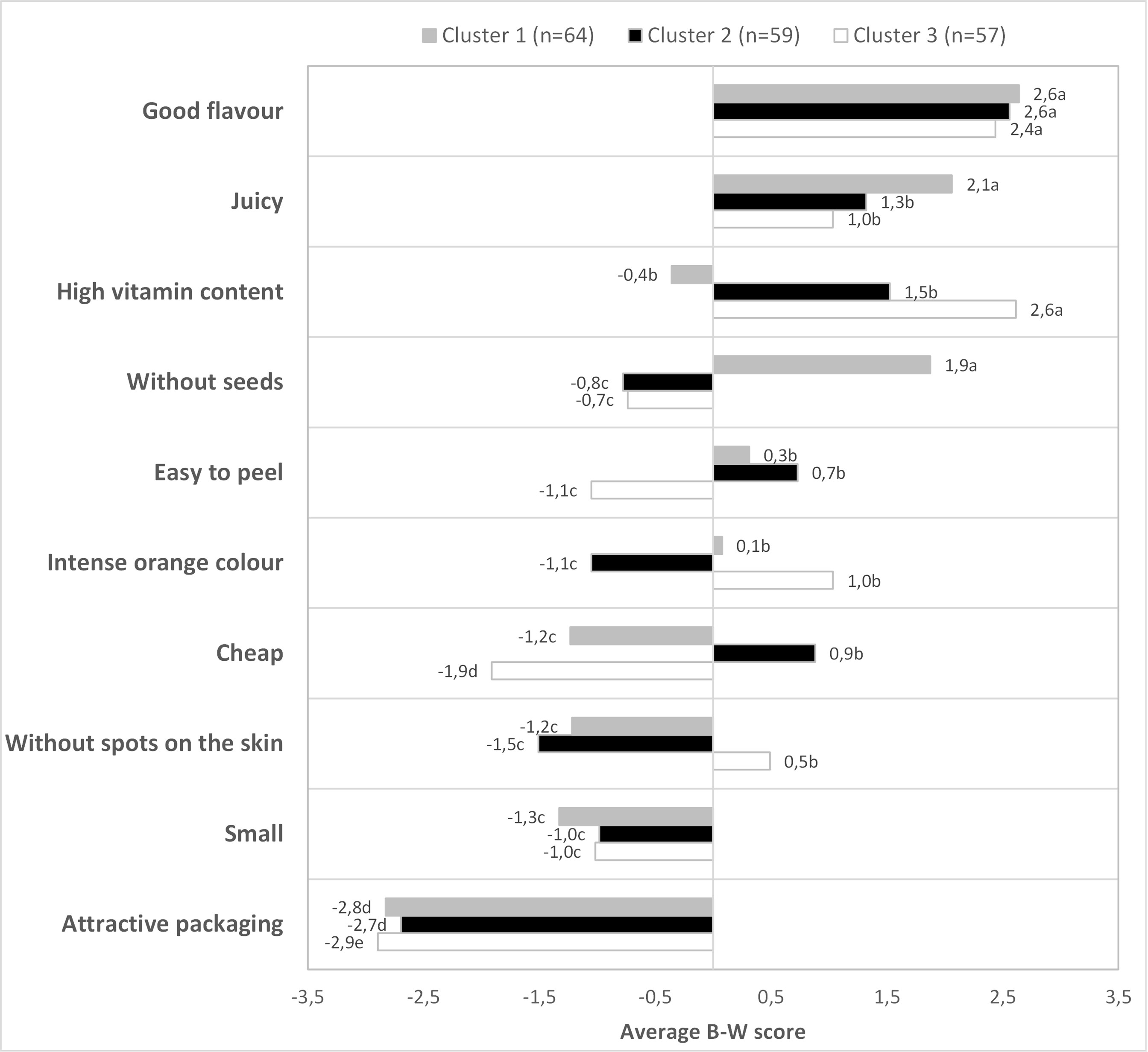Uruguayan consumers' perception of mandarins
insights for selection and marketing of new cultivars
DOI:
https://doi.org/10.31285/AGRO.25.530Keywords:
breeding, citrus, flavor, sensory, fruit qualityAbstract
A better understanding of the key characteristics influencing consumers' perception and purchase decisions of mandarins can contribute to the selection of new cultivars that assertively meet their needs and expectations, as well as to the development of strategies to increase mandarin consumption in the different markets. In this context, the aims of the present work were: i) to explore Uruguayan consumers' perception of mandarins, and ii) to identify the key characteristics that drive mandarin purchase decisions. A consumer study with 197 consumers was conducted in a supermarket in the metropolitan area of Montevideo (Uruguay). A word-association task was used to identify consumers' associations with mandarins, whereas a best-worst scaling was used to estimate the relative importance of specific characteristics. Results from the word association task revealed that sensory characteristics (juiciness, sweetness, color, flavor and odor) were the most salient concepts associated with a mandarin, followed by fruit characteristics and consumption context. Mandarin flavor was identified as the most important characteristic underlying consumers' purchase decisions in the best-worst scaling, followed by juiciness and high vitamin content; while packaging, size or price resulted less relevant. Consumer segments who attached different relative importance to vitamin content, price, lack of seeds and easiness to peel were identified. Results from the present work suggest that strategies to increase mandarin consumption should focus on sensory and hedonic aspects rather than package appearance or health-related ones.
Downloads
References
Bi X, House L, Gao Z, Gmitter F. Estimating willingness to pay for new mandarin cultivars: a revealed preference approach [Internet]. Florida: IFAS Extension; 2014 [cited 2021 Apr 12]. 6p. Available from: https://bit.ly/3g4Lc1S.
Campbell BL, Nelson RG, Ebel RC, Dozier WA. Mandarin attributes preferred by consumers in grocery stores. HortScience. 2006;41(3):664-70.
Goldenberg L, Yaniv Y, Kaplunov T, Doron-Faigenboim A, Porat R, Carmi N. Genetic diversity among mandarins in fruit-quality traits. J Agric Food Chem [Internet]. 2014 [cited 2021 Apr 12];62(21):4938-46. Available from: https://bit.ly/3mEEdOl.
Goldenberg L, Yaniv Y, Porat R, Carmi N. Mandarin fruit quality: a review. J Sci Food Agric. 2018;98(1):18-26.
Hijaz F, Gmitter JFG, Bai J, Baldwin E, Biotteau A, Leclair C, McCollum TG, Plotto A. Effect of fruit maturity on volatiles and sensory descriptors of four mandarin hybrids. J Food Sci. 2020 [cited 2021 Apr 12];85(5):1548-65. Available from: https://bit.ly/2OHTxNJ.
Hollywood LE, Armstrong GA, Durkin MG. Using behavioural and motivational thinking in food segmentation. Int J Retail Distrib Manag. 2007;35(9):691-702.
House LA, Gao Z, Spreen TH, Gmitter JFG, Valim MF, Plotto A, Baldwin EA. Consumer preference for mandarins: implications of a sensory analysis. Agribusiness. 2011;27(4):450-64.
Köster EP. The psychology of food choice: some often encountered fallacies. Food Qual Prefer. 2003;14:359-73.
Krippendorff K. Content analysis: an introduction to its methodology. Thousand Oaks (CA): Sage Publications; 2004. 472p.
Kurzer AB, Bechtel R, Guinard JX. Adult and child focus group views of oranges and mandarins. HortTechnology. 2019;29(4):408-16.
Lado J, Cuellar F, Rodrigo MJ, Zacarías L. Nutritional Composition of Mandarins. In: Simmonds MSJ, Preedy VR, editors. Nutritional Composition of Fruit Cultivars. Amsterdam: Elsevier; 2016. p. 419-43.
Lado J, Moltini AI, Vicente E, Rodríguez G, Rodríguez M, López M, Billiris A, Ares G. Integration of sensory analysis into plant breeding: a review. Agrociencia Uruguay. 2019;23(1):1-15.
Lado J, Vicente E, Moltini AI, Alcaire F, Ares G. Integrating consumer perception in the selection of purple‐skin sweet potato cultivars. J Sci Food Agric[Preprint]. 2020[cited 2021 Apr 12]. Available from: https://bit.ly/3a50jo0.
Louviere JJ, Flynn TN, Marley AAJ. Best-Worst scaling: theory, methods and applications. Cambridge (UK): Cambridge University Press; 2015. 342p.
Machín L, Antúnez L, Curutchet MR, Ares G. The heuristics that guide healthiness perception of ultra-processed foods: a qualitative exploration. Public Health Nutr. 2020;23(16):2932-40.
Mesías FJ, Escribano M. Projective techniques. In: Ares G, Varela P, editors. Methods in Consumer Research. 2nd ed. Duxford (UK): Woodhead Publishing Limited; 2018. p. 79-102.
Morales J, Tárrega A, Salvador A, Navarro P, Besada C. Impact of ethylene degreening treatment on sensory properties and consumer response to citrus fruits. Food Res Int [Internet]. 2020 [cited 2021 Apr 12];127:108641. Available from: https://bit.ly/3uKyedy.
Ollitrault P, Navarro L. Citrus. In: Badenes ML, Byrne DH, editors. Fruit Breeding. New York: Springer; 2012. p. 623-62.
Pettigrew S. Pleasure: an under-utilised ‘P’ in social marketing for healthy eating. Appetite [Internet]. 2016 [cited 2021 Apr 12];104:60-9. Available from: https://bit.ly/3dXUXvY.
Poole N, Baron L. Consumer awareness of citrus fruit attributes. Br Food J. 1996;98(1):23-8.
Sdiri S, Cuenca J, Navarro P, Salvador A, Bermejo A, Salvador A. New triploids late‑maturing mandarins as a rich source of antioxidant compounds. Eur Food Res Technol [Internet]. 2020 [cited 2021 Apr 12];246:225-37. Available from: https://bit.ly/3wPAHFt.
Tarancón P, Tárrega A, Aleza P, Besada C. Consumer description by Check-All-That-Apply questions ( CATA ) of the sensory profiles of commercial and new mandarins: identification of preference patterns and drivers of liking. Foods [Internet]. 2020 [cited 2021 Apr 12];9:468. Available from: https://bit.ly/3tc26Pz.
Vicente E, Ares G, Rodríguez G, Varela P, Bologna F, Lado J. Selection of promising sweet potato clones using projective mapping. J Sci Food Agric [Internet]. 2017;97(1):158–64. Available from: https://bit.ly/3wV1Cjj.
Vicente E, Varela P, de Saldamando L, Ares G. Evaluation of the sensory characteristics of strawberry cultivars throughout the harvest season using projective mapping. J Sci Food Agric [Internet]. 2014 [cited 2021 Apr 12];94(3):591-9. Available from: https://bit.ly/3dbqmMd.
Zou Z, Xi W, Hu Y, Nie C, Zhou Z. Antioxidant activity of Citrus fruits. Food Chem [Internet]. 2015 [cited 2021 Apr 12];196:885-96. Available from: https://bit.ly/3gajMYx.

Published
How to Cite
Issue
Section
| Article metrics | |
|---|---|
| Abstract views | |
| Galley vies | |
| PDF Views | |
| HTML views | |
| Other views | |

















